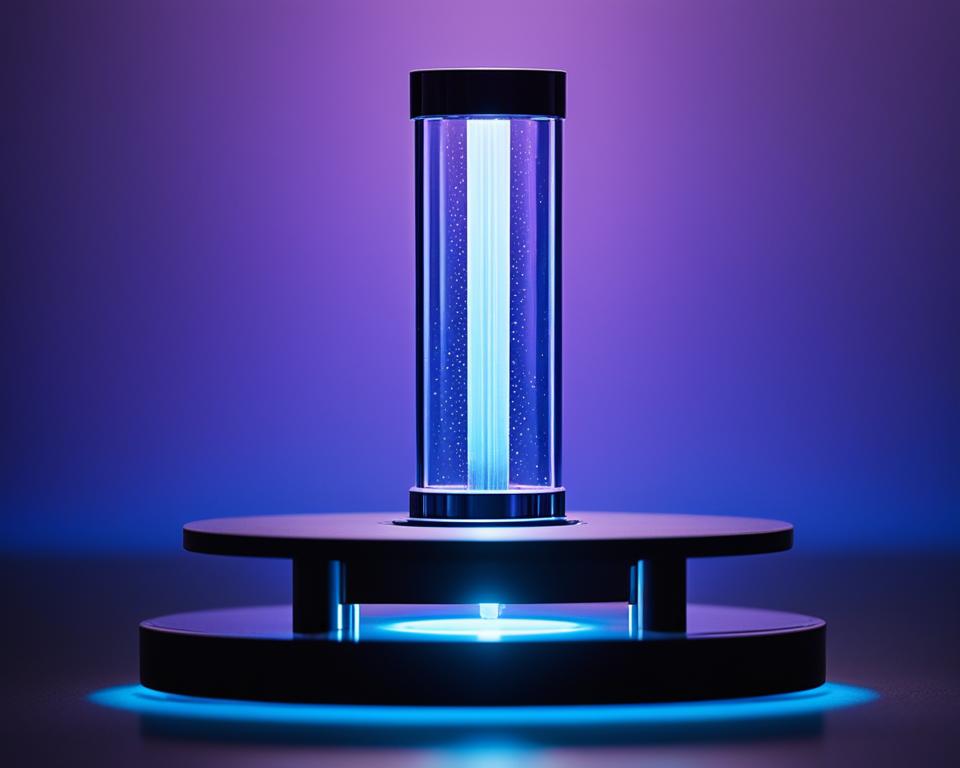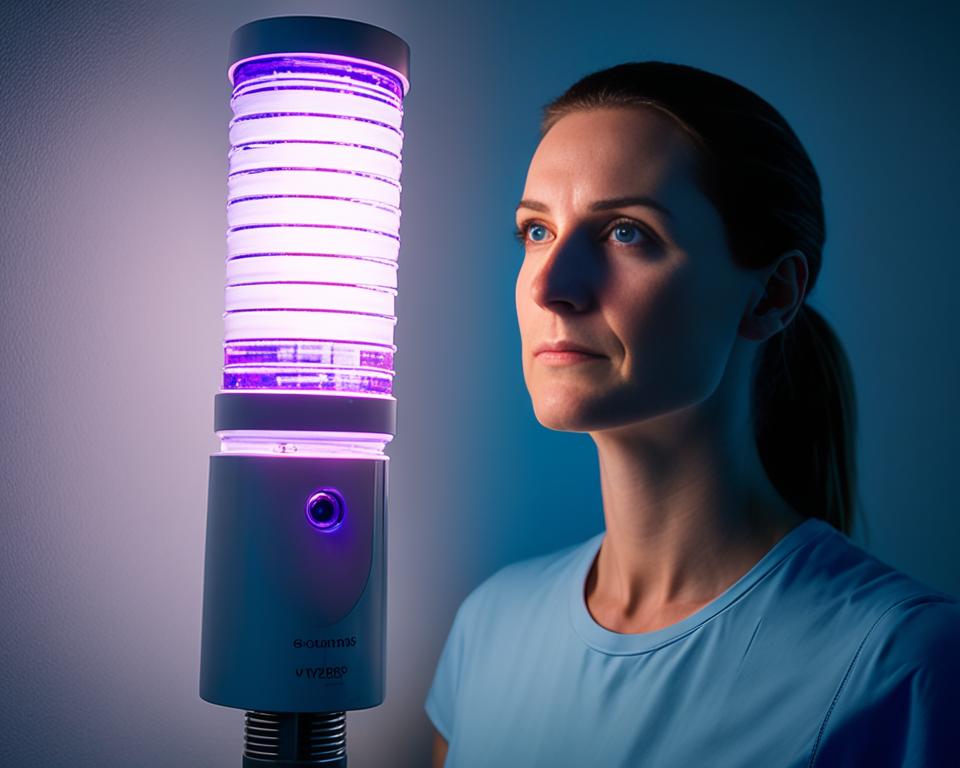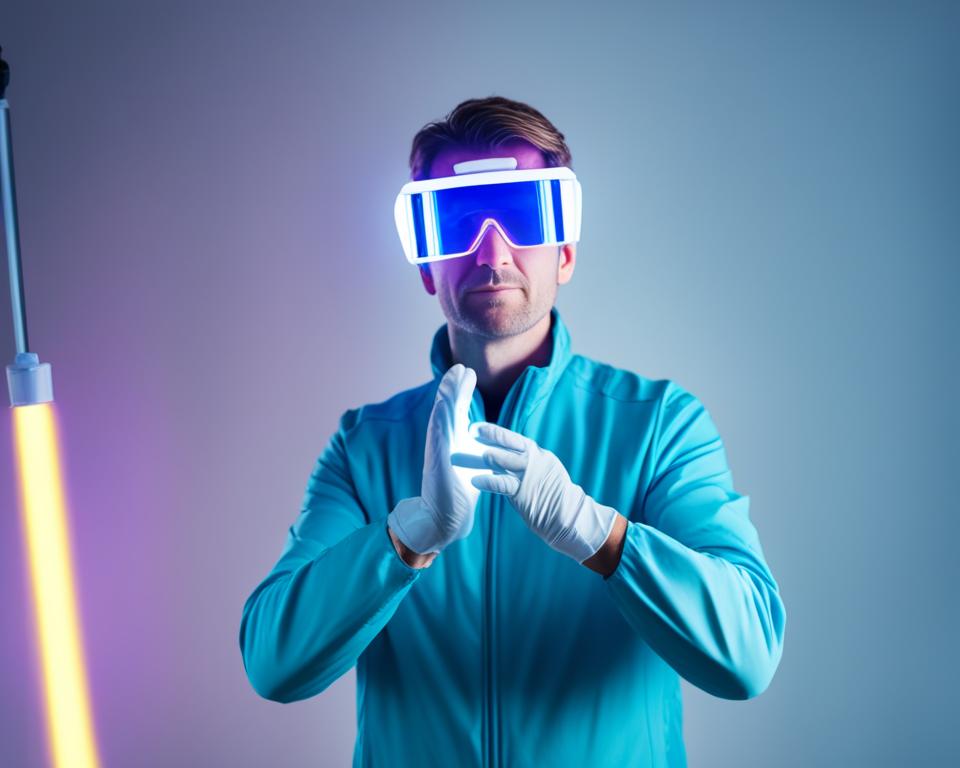Welcome to our comprehensive guide on UVC light dangers. In this article, we will explore the potential hazards associated with UVC light and the importance of using UV germicidal technology safely and responsibly for effective disinfection. By understanding these risks, you can take the necessary precautions to protect yourself and others from harm.
UVC light, also known as ultraviolet C light, is a powerful form of radiation that is commonly used for its germicidal properties. It has the ability to destroy microorganisms and is often employed in healthcare facilities, laboratories, and other settings where disinfection is essential.
However, it is crucial to be aware of the potential dangers associated with UVC light exposure. This includes the risks to our skin, eyes, and immune system. Understanding these effects and taking appropriate precautions is vital to ensure our safety and wellbeing.
In the following sections, we will delve deeper into the basics of UVC light, its radiation effects on human health, and the potential hazards of UVC light exposure. We will also provide safety tips for both occupational settings and home use of UVC light devices.
Additionally, we will discuss the risks associated with UV germicidal lamps, the importance of regular testing and maintenance, compliance with safety standards, and the need to educate others about UVC light dangers.
By the end of this article, you will have a comprehensive understanding of UVC light dangers and the necessary steps to ensure safe and responsible use of UV germicidal technology. Let’s begin our journey into the world of UVC light and its associated risks.
Read more interesting information at ::lesdamesmiami
The Basics of UVC Light
Understanding the fundamental characteristics of UVC light is essential in grasping its potential dangers and how to mitigate them. UVC light, also known as ultraviolet C light, is a type of ultraviolet light with a wavelength between 100 and 280 nanometers. It falls within the highest energy range of ultraviolet light and is widely recognized for its germicidal properties.
In the context of germicidal applications, UVC light is used to eliminate harmful microorganisms such as viruses, bacteria, and mold. It disrupts the DNA or RNA structure of these pathogens, rendering them unable to replicate or cause infection.
However, it’s important to acknowledge that UVC light poses certain risks when exposed to living organisms, including humans. Direct or prolonged exposure to UVC light can have adverse effects on the skin and eyes, as well as potential implications for overall health.
UVC light has a higher energy level compared to UVA and UVB light, which makes it more biologically damaging. When UVC radiation interacts with the skin, it can lead to sunburn-like symptoms such as redness, inflammation, and in extreme cases, blistering or peeling. Additionally, UVC light can cause acute and chronic eye injuries, including corneal damage, conjunctivitis, and even cataracts.
“Proper precautions must be taken to minimize the risks associated with UVC light exposure.”
The Hazards of UVC Light Exposure
While UVC light has valuable uses in disinfection, it is crucial to understand the potential hazards associated with its exposure. The amount of UVC light exposure required to cause immediate harm can vary depending on various factors, including the intensity and duration of exposure, distance from the light source, and individual sensitivity. Nevertheless, it is vital to exercise caution and implement safety measures.
- Skin Burns: UVC light can cause burns similar to those caused by excessive sun exposure. Acute exposure can lead to erythema (redness), edema (swelling), and pain, while chronic or repeated exposure can result in more severe damage.
- Eye Injuries: UVC radiation can cause various eye injuries, ranging from mild irritation to severe damage. Short-term effects may include photoconjunctivitis (inflammation of the conjunctiva) and photokeratitis (inflammation of the cornea). Long-term exposure may contribute to the development of cataracts.
- Potential DNA Damage: UVC light has the ability to cause direct damage to DNA, which can lead to mutations and potential long-term health risks. While ample precautions can reduce the risk, prolonged or intense UVC exposure may pose a risk to genetic material.
It is essential to prioritize safety measures and minimize unnecessary exposure to UVC light, especially during germicidal activities. Implementing protective measures such as wearing appropriate personal protective equipment (PPE), maintaining distance from UVC sources, and following recommended exposure guidelines can help mitigate the potential risks associated with UVC light exposure.
Understanding UVC Radiation Effects on Human Health
When it comes to UVC light, it is important to be aware of the potential effects it can have on human health. Exposure to UVC radiation can lead to both short-term and long-term risks, affecting various aspects of our well-being. In this section, we will explore the specific effects of UVC radiation on the skin, eyes, and immune system, highlighting the importance of responsible usage and protective measures.
The Impact on Skin
UVC radiation can have harmful effects on the skin, particularly when exposed to high levels or over extended periods. It is known to cause acute damage such as sunburn, skin redness, and irritation. Prolonged and repeated exposure to UVC radiation can increase the risk of developing long-term skin conditions, including premature aging, wrinkles, and even skin cancer.
It is crucial to protect the skin from UVC radiation by using appropriate barriers such as protective clothing, gloves, and sunscreen with a high sun protection factor (SPF). Minimizing direct exposure to UVC light and seeking shade when possible can also help reduce the risk of skin damage.
The Effects on Eye Health
UVC radiation poses a significant risk to the eyes, as they are highly sensitive to this type of light. Exposure to UVC radiation can lead to various eye conditions, such as corneal burns, inflammation, and damage to the crystalline lens. Symptoms may include redness, grittiness, sensitivity to light, and blurred vision.
It is essential to use appropriate eye protection, such as safety goggles or UV-blocking glasses, when working with UVC light sources. In occupational settings where UVC exposure is common, employers should provide proper eye protection and enforce safety protocols to prevent eye injuries.
Impact on the Immune System
UVC radiation can also affect the immune system, our body’s defense against pathogens and diseases. Research shows that UVC exposure suppresses immune function, making individuals more susceptible to infections and other health problems. This can have far-reaching consequences, especially for individuals with compromised immune systems or chronic illnesses.
Understanding the potential harms of UVC radiation on the immune system emphasizes the need for strict safety measures and adherence to guidelines when utilizing UVC light technology. This includes maintaining proper distance from UVC sources, limiting exposure time, and implementing effective ventilation systems to minimize the risk of immune dysfunction.
| UVC Radiation Effects on Human Health | |
|---|---|
| Skin | Acute damage, premature aging, increased risk of skin cancer |
| Eyes | Corneal burns, inflammation, damage to the crystalline lens |
| Immune System | Suppression of immune function, increased susceptibility to infections |
It is crucial to prioritize safety and take proactive measures to minimize exposure to UVC radiation. By understanding its effects on the skin, eyes, and immune system, we can ensure the responsible use of UVC light technology while safeguarding our health and well-being.
Potential Hazards of UVC Light Exposure
While UVC light is a powerful tool for germicidal purposes, it is essential to be aware of the potential hazards and dangers associated with UVC light exposure. Safely using UVC light is crucial to protect yourself and others from adverse effects.
Possible Skin Burns
Direct exposure to UVC light can cause skin burns, similar to a sunburn.UV radiation damages the skin cells and can result in pain, redness, and even blistering. It is important to avoid direct skin contact with UVC light sources and use protective clothing or equipment when necessary.
Risks to the Eyes
UVC light can be harmful to the eyes and cause various eye injuries.Direct or indirect exposure to UVC radiation can lead to eye irritation, inflammation, and potentially more severe conditions such as cataracts or damage to the cornea. It is crucial to protect your eyes by wearing appropriate safety goggles or eye shields when working with UVC light.
Potential DNA Damage
UVC light has the potential to cause DNA damage in living organisms if proper precautions are not taken.Exposure to UVC radiation can lead to mutations in DNA, which can have long-term health effects. It is essential to ensure that UVC light devices are operated safely and in accordance with recommended guidelines to minimize the risk of DNA damage.
To minimize the hazards associated with UVC light exposure, it is important to follow these safety tips:
- Always wear appropriate protective clothing, such as gloves and long sleeves, to reduce direct skin exposure to UVC light.
- Use protective eyewear, such as safety goggles or eye shields, to safeguard your eyes from UVC radiation.
- Ensure proper ventilation in the area where UVC light devices are used to minimize the risk of inhaling ozone produced during the disinfection process.
- Follow the manufacturer’s instructions for operating UVC light devices, including recommended exposure times, distances, and safety precautions.
- Regularly inspect and maintain UVC light devices to ensure they are functioning correctly and safely.
By being aware of the potential hazards and implementing safety measures, you can effectively minimize the risks associated with UVC light exposure. Prioritizing safety ensures that you can harness the power of UVC light for germicidal purposes while protecting yourself and those around you from any harmful effects.
Understanding UV Germicidal Lamps and Their Risks
UV germicidal lamps are powerful devices that emit ultraviolet (UV) light to effectively kill bacteria, viruses, and other harmful microorganisms. While these lamps are widely used for disinfection purposes in various settings, it is important to understand the potential risks associated with their operation.
One of the primary concerns when using UV germicidal lamps is the risk of mercury exposure. Most UV lamps contain a small amount of mercury, which is a toxic substance. In the event of accidental breakage, mercury vapor can be released, posing a health hazard to individuals in the vicinity. Proper handling, installation, and maintenance of UV lamps are essential to minimize the risk of mercury exposure.
Another risk associated with UV germicidal lamps is the production of ozone. When UV light interacts with oxygen in the air, ozone can be generated as a byproduct. While ozone is effective in eliminating odors and sanitizing the environment, high levels of ozone can be harmful to human health, especially when inhaled. It is crucial to use UV lamps in well-ventilated spaces and ensure that ozone concentrations remain within safe limits.
Accidental exposure to UV light emitted by germicidal lamps can also pose dangers to human health. Prolonged or direct exposure to UVC light can cause skin burns, similar to a sunburn, and may lead to long-term skin damage. Additionally, UVC radiation can cause eye injuries, such as corneal damage and cataracts, if appropriate eye protection is not used.
To minimize the risks associated with UV germicidal lamps, it is essential to follow safety guidelines and implement appropriate precautions. This includes wearing protective equipment such as gloves and goggles when handling UV lamps, ensuring proper ventilation to prevent the accumulation of ozone, and implementing safety protocols for lamp installation and maintenance.
It is crucial to use UV lamps in well-ventilated spaces and ensure that ozone concentrations remain within safe limits.
When operating UV germicidal lamps, it is important to be aware of potential risks and take necessary precautions to protect both individuals and the surrounding environment. By understanding the hazards and implementing appropriate safety measures, UV germicidal lamps can be effectively used for disinfection while minimizing potential health risks.

| Risks | Precautions |
|---|---|
| Mercury exposure | – Handle lamps with care to avoid breakage – Follow proper disposal procedures – Use lamps with low-mercury content |
| Ozone production | – Ensure proper ventilation in the room – Monitor ozone levels regularly – Use UV lamps with ozone-reducing features |
| UV light exposure | – Wear appropriate protective equipment (gloves, goggles) – Follow recommended exposure time limits – Install lamps in areas inaccessible to people |
UVC Light Dangers in Occupational Settings
Occupational settings that utilize UV germicidal technology for disinfection purposes expose workers to potential hazards and risks associated with UVC light. It is crucial to understand these dangers and implement safety measures to protect the well-being of employees.
In occupational settings, the concentration of UVC light sources is typically higher, increasing the risk of adverse effects. Continuous exposure to UVC light can have detrimental consequences on the skin, eyes, and immune system. Therefore, it is essential to adhere to safety regulations and guidelines to minimize the potential hazards.
Employers must prioritize the safety of their employees by providing adequate training on UVC light dangers and implementing protective measures. This includes ensuring the use of appropriate personal protective equipment (PPE) such as gloves, safety goggles, and protective clothing when working with UVC light sources.
Furthermore, establishing clear protocols for UVC light operation and maintenance is essential. Regular inspections and proper documentation help prevent accidents and address any potential risks promptly. By implementing these measures, employers can create a safe working environment and mitigate the dangers associated with UVC light exposure.
Below is a table summarizing some of the potential hazards of UVC light exposure in occupational settings:
| Hazard | Potential Consequences |
|---|---|
| Skin Burns | Redness, blistering, and tissue damage |
| Eye Injuries | Corneal damage, conjunctivitis, and vision impairment |
| Immune System Suppression | Increased susceptibility to infections and illnesses |
| DNA Damage | Potential risk of genetic mutations and long-term health issues |
It is crucial for employers and employees alike to recognize the dangers of UVC light exposure and prioritize safety. By adhering to safety regulations, providing adequate training, and implementing protective measures, occupational settings can minimize the potential hazards associated with UVC light, ensuring the well-being of their workforce.
UVC Light Safety Precautions for Home Use
When it comes to keeping our homes clean and germ-free, many individuals are turning to UVC light devices or germicidal lamps for added disinfection. However, it is essential to understand the potential dangers associated with UVC light and take necessary precautions to ensure safe usage. Implementing proper safety measures will not only protect you and your family but also maximize the effectiveness of UVC light for disinfection purposes.
Proper Usage
Before using any UVC light device or germicidal lamp, it is crucial to read the manufacturer’s instructions and follow them carefully. Pay attention to recommended exposure times and distances to prevent overexposure. It is also essential to avoid direct UVC light exposure to the skin and eyes.
Tip: Use timers or set alarms to ensure you don’t exceed the recommended exposure time when using UVC light for disinfection in your home.
Protective Equipment
Whenever handling UVC light devices or germicidal lamps, it is advisable to wear appropriate protective equipment. This may include safety goggles, disposable gloves, and protective clothing that covers your skin. These precautions can significantly reduce the risk of UVC light exposure injuries.
Safe Handling of UVC Light Sources
When using UVC light devices or germicidal lamps, it is essential to handle them with care. Avoid touching the UVC bulbs directly, as the oils from your skin can cause damage and reduce their effectiveness. If a bulb needs replacement, make sure to use the correct type and follow the manufacturer’s instructions for installation.
Proper Storage
When not in use, store your UVC light devices or germicidal lamps in a safe place, away from the reach of children and pets. Ensure they are stored securely to prevent accidental breakage or damage, which could lead to unintended UVC light exposure.
Regular Maintenance
To ensure the optimal performance and safety of your UVC light devices or germicidal lamps, it is essential to perform regular maintenance. This may include cleaning the bulbs regularly, inspecting for any signs of wear or damage, and replacing bulbs as recommended by the manufacturer.
Safe Disposal
When disposing of UVC light bulbs or devices, it is important to follow local regulations and guidelines. Some UVC bulbs may contain small amounts of mercury, making proper disposal crucial to prevent environmental contamination. Contact your local waste management facility for guidance on how to dispose of UVC light bulbs safely.
By following these UVC light safety precautions for home use, you can harness the power of UVC light for effective disinfection while minimizing potential risks. Remember, responsible use and proper safety measures are key to fully reaping the benefits of UVC light technology within the comfort of your home.
Understanding Ultraviolet Disinfection Precautions
When it comes to implementing ultraviolet (UV) disinfection systems, whether in healthcare facilities or other environments, it is essential to prioritize safety and adhere to established precautions. By understanding and implementing the right protocols, we can harness the power of UV light while minimizing potential risks. This section will outline key precautions to consider when utilizing UV disinfection methods, ensuring the well-being of both users and patients.
The Importance of Exposure Time
One crucial aspect of UV disinfection is exposure time. Different microorganisms require varying amounts of UV exposure to effectively neutralize them. It is crucial to refer to industry guidelines and specifications to determine the appropriate duration for achieving the desired disinfection level. By adhering to recommended exposure times, we can ensure optimal disinfection results while maintaining safe operating conditions.
Dosage Calculations for Effective Disinfection
Accurately calculating the UV dosage necessary for targeted disinfection is of paramount importance. Dosage refers to the amount of UV energy delivered to a specific area over a given period. To determine the appropriate dosage, factors like the size and type of the area being disinfected, as well as the target microorganisms, must be considered. Engineering controls, such as UV sensors and monitors, can aid in measuring and validating dosage levels, facilitating precise disinfection processes.
Safety Protocols for UV Disinfection
Implementing established safety protocols is vital for minimizing potential risks associated with UV disinfection. These protocols include measures such as using personal protective equipment (PPE) to shield operators from direct UV exposure, following proper handling and maintenance procedures, and ensuring adequate ventilation in the disinfection area. It is also essential to establish clear signage and restrict access to the disinfection zone during operation to prevent accidental exposure.
“Adhering to established safety protocols for UV disinfection is crucial for ensuring the well-being of both users and patients.”
Continuous Monitoring and Training
Regular monitoring and maintenance of UV disinfection systems are essential to guarantee their continued effectiveness and safety. Ongoing system checks, including lamp replacement and cleaning routines, help prevent the degradation of UV output and potential hazards. Additionally, providing comprehensive training programs for operators and staff is crucial to ensure they are well-informed about potential risks and properly equipped to implement the necessary safety measures.
Implementing Ultraviolet Disinfection Precautions: A Summary
By understanding and implementing key precautions, such as considering exposure time, calculating appropriate dosage, following safety protocols, and prioritizing continuous monitoring and training, we can minimize risks associated with UV disinfection. Emphasizing safety in UV disinfection practices is essential to harness the power of UV light for efficient and effective disinfection while safeguarding the well-being of all involved.
Next, we will explore the potential risks and dangers of UVC light exposure in occupational settings, where UV germicidal technology is commonly used.
UVC Light Dangers and Vulnerable Populations
Vulnerable populations, such as infants, elderly individuals, and those with certain medical conditions, are particularly susceptible to the potential hazards of UVC light exposure. It is essential to take additional safety measures and adhere to guidelines to protect these groups from the risks associated with UVC light.
Infants have delicate skin and underdeveloped immune systems, making them more vulnerable to the harmful effects of UVC radiation. It is crucial to limit their exposure to UVC light and ensure they are not directly exposed to UV germicidal lamps or devices.
Elderly individuals often have thinning skin, which can increase their risk of developing burns and other UVC-related skin injuries. Additionally, their immune systems may not be as robust, making them more susceptible to infections. Proper precautions should be taken to minimize their UVC light exposure and protect their overall well-being.
People with certain medical conditions, such as photosensitivity disorders or compromised immune systems, may have heightened sensitivity to UVC light. Their conditions may exacerbate the potential hazards of UVC light exposure, necessitating extra precautions and strict adherence to safety guidelines.
Safety Measures for Protecting Vulnerable Populations
When using UVC light devices or UV germicidal lamps in environments where vulnerable populations are present, it is essential to prioritize their safety and well-being. Below are some recommended safety measures:
- Ensure that UVC light devices are used in enclosed areas or with appropriate shielding to prevent direct exposure to individuals.
- Implement strict protocols for UVC light usage, including designated operational times and clear signage to communicate potential hazards to caregivers, patients, or residents.
- Provide appropriate protective equipment, such as UV-blocking goggles or garments, to minimize the risk of eye and skin injuries.
- Regularly assess and maintain UVC light devices to ensure their efficacy and safety standards.
- Train and educate healthcare professionals, caregivers, and staff members on the potential dangers of UVC light, emphasizing the importance of following safety protocols.
- Consult with medical experts or specialists to assess the specific risks and develop tailored safety measures for individuals with medical conditions.
By implementing these safety measures and guidelines, healthcare facilities, caregivers, and individuals can effectively reduce the potential hazards of UVC light exposure for vulnerable populations.
Importance of UVC Light Testing and Maintenance
Regular testing and maintenance of UVC light devices and UV germicidal lamps are essential to ensure their optimal performance and, more importantly, to mitigate the potential risks associated with their use. Faulty or outdated equipment can pose significant dangers, compromising both safety and effectiveness.
To guarantee the safe and efficient operation of UVC light devices, it is crucial to establish a comprehensive testing and maintenance routine. This includes regular inspections, performance evaluations, and necessary repairs or replacements. Such proactive measures help identify any issues early on and prevent hazardous situations from arising.
Benefits of Regular Testing and Maintenance
By prioritizing regular testing and maintenance practices, individuals and organizations using UVC light technology can reap several important benefits:
- Enhanced Safety: Routine inspections and servicing minimize the risk of malfunctions, such as faulty electrical connections or deteriorating lamp components that could lead to accidents or injuries.
- Optimized Functionality: Regular maintenance ensures that UVC light devices operate at their intended performance levels, delivering the required germicidal intensity for effective disinfection.
- Prolonged Lifespan: By promptly identifying and addressing potential issues, maintenance practices contribute to extending the lifespan of UVC light devices and UV germicidal lamps, thereby maximizing their value and cost-effectiveness.
- Compliance with Standards: Regular testing and maintenance help ensure adherence to applicable safety regulations and guidelines established by regulatory bodies and industry standards.
To establish an effective testing and maintenance plan:
“Develop a schedule that aligns with the manufacturer’s recommendations and industry best practices. Document all maintenance activities, including inspections, cleaning procedures, and repairs. Ensure that trained personnel carry out these tasks.”
Additionally, it is crucial to stay informed about any updates or recalls related to UVC light devices and UV germicidal lamps. Regularly check the manufacturer’s website for product-specific information and guidance on maintenance and safety protocols.
Remember, neglecting testing and maintenance can result in compromised performance, increased safety risks, and reduced effectiveness in disinfection. By prioritizing these vital activities, individuals and organizations can confidently harness the power of UVC light technology while safeguarding against potential hazards.

Compliance with UVC Light Safety Standards
Ensuring safety when using UVC light for germicidal purposes requires adherence to established safety standards and regulations. These measures are crucial in mitigating the potential hazards associated with UVC light exposure. By choosing certified products and following recommended guidelines, users can prioritize safety and efficacy in their disinfection practices.
Regulatory organizations worldwide have established safety standards specifically designed to address the dangers of UVC light. These standards include guidelines for manufacturers, users, and occupational settings that employ UV germicidal lamps or UVC light devices. Compliance with these standards is essential to minimize health risks and prevent any negative consequences.
Professional organizations such as the International Ultraviolet Association (IUVA) and governmental agencies like the Occupational Safety and Health Administration (OSHA) provide valuable resources and recommendations on UVC light safety. These resources outline best practices for controlling exposure, implementing proper ventilation, and using appropriate personal protective equipment (PPE).
Choosing certified products from reputable manufacturers is crucial in ensuring that UVC light devices meet stringent safety standards. Look for certification labels and documentation that demonstrate compliance with recognized safety regulations. Additionally, manufacturers often provide detailed instructions on safe usage and maintenance of their products.
It is important to note that using uncertified or substandard UVC light devices can pose significant risks. These may include inadequate shielding, improper wavelength output, or faulty electrical components, which could lead to harmful exposure or device malfunction. Therefore, always prioritize safety by selecting products from trusted sources.
By complying with safety standards and utilizing certified UVC light devices, users can minimize the potential health risks associated with UVC light exposure. It is crucial that individuals and organizations take proactive measures and foster a culture of safety when utilizing UV germicidal technology for disinfection purposes.
Educating Others on UVC Light Dangers
Ensuring the safe use of UVC light requires not only personal responsibility but also a collective effort to educate others on the potential dangers and promote safe practices. By raising awareness among professionals and the general public, we can minimize the risks associated with UVC light exposure and create a safer environment for all.
Proper labeling and clear instructions play a crucial role in educating users about UVC light dangers. Manufacturers should provide comprehensive information on the potential hazards, recommended safety precautions, and proper usage guidelines. This information should be easily accessible and clearly displayed on the packaging or accompanying materials.
“It is essential to ensure that individuals have access to accurate and up-to-date information regarding the risks associated with UVC light exposure. Empowering users with knowledge is the first step towards creating a safer environment.”
Training programs and workshops can be organized to promote awareness and understanding of the potential dangers of UVC light. These educational initiatives should target professionals working in industries where UVC light is commonly used, such as healthcare, hospitality, and janitorial services. By providing them with the necessary knowledge and skills, we can help them implement appropriate safety measures and protect themselves and others.
Importance of Public Awareness
Public awareness campaigns are essential in educating the general population about UVC light dangers. Through various channels, such as social media, websites, and information brochures, we can disseminate crucial information and safety tips. These campaigns can also debunk common myths and misconceptions surrounding UVC light, ensuring that accurate information reaches the public.
By emphasizing the importance of personal protective equipment (PPE) and safe handling practices, we can empower individuals to take the necessary precautions when using UVC light devices or germicidal lamps. Highlighting real-life examples and case studies can also serve as powerful educational tools, illustrating the potential consequences of inadequate safety measures.
Collaboration with Stakeholders
Collaboration between various stakeholders, including manufacturers, industry associations, and regulatory bodies, is crucial in the effort to educate others about UVC light dangers. These collaborations can lead to the development of best practices and safety guidelines, ensuring a standardized approach to UVC light use.
Scientific research and continuous monitoring of UVC light technology can also provide valuable insights into the potential risks and safety measures associated with its use. By supporting and promoting these initiatives, we can stay up to date with the latest advancements in UVC light safety and share this knowledge with others.
Conclusion
Throughout this article, we have explored the dangers associated with UVC light and emphasized the importance of understanding and mitigating these risks for safe and effective use of UV germicidal technology. It is crucial to recognize that while UVC light can be a powerful tool for disinfection, improper handling and exposure can lead to serious health hazards.
By educating ourselves and others about the potential dangers of UVC light, we can ensure the implementation of proper safety precautions. This includes using certified UV germicidal lamps, following recommended guidelines for exposure limits, and prioritizing the safety of vulnerable populations.
As we continue to combat the challenges of infectious diseases and focus on maintaining clean and hygienic environments, it is essential to approach the use of UVC light with caution and responsibility. By doing so, we can harness the power of UVC light for effective disinfection while preserving the well-being of individuals and communities.



